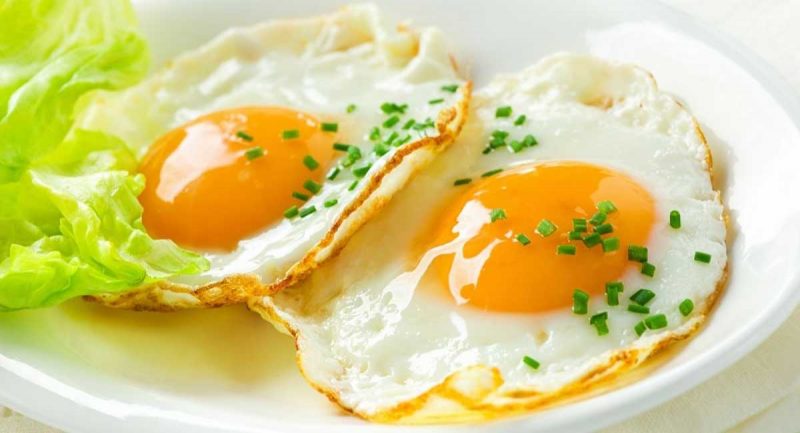On a diet? Started counting your daily calorie input? We salute that. Healthy eating habits are the way to a healthy and fit body. Whether you are doing it to complement your workouts, lose weight, or provide your body with balanced nutrition, it’s important to know how to measure your caloric intake.
Eggs are a famous superfood, rich in protein and energy that fuels the body. No wonder eggs are such a prominent staple for breakfast. They are rich in most of what the body needs to kickstart the daily routine, including the quick-energy release from fat and the protein that releases energy later on in the day.
Eggs, given their high protein absorption rate, are also known to be superfood for gym enthusiasts. They have from 90 to 99 percent protein take out—the highest among any food. Eggs are also full of fast-absorbing protein, faster even than the casein in milk.

Table of Contents
Nutritional Facts of Eggs: The Breakdown
Note: This article is examining average-sized chicken eggs. The nutritional facts can vary by the shape of the egg and its origin. Eggs of different birds can have slightly different stats. In this article, we are using a 50-gram chicken egg as a muster.
An average chicken egg starts at 75-80 calories. The two main sources of these calories are the proteins found mostly in the egg white and fat which is mostly found in the yolk.
Note that mostly does not mean there is no protein in yolk and no fat in egg white. Actually, an average yolk contains 2.5 grams of protein and amino acids—so think twice before separating them. It can often be better to have the whole thing (minus the shell).
Carbs are almost non-existent (doesn’t apply for keto-diet) with a carb content of 0.6 grams per egg.
The breakdown of energy goes:
- Protein: 6.3 grams
- Total Fat: 5.3 grams
- Carbohydrates: 0.6 grams
Most of the proteins are fast-absorbing proteins while the fat content consists of 2 grams of monounsaturated fat and about 1.5 to 1.7 grams of saturated fat. The cholesterol count is about 210-215 mg.
Also Good to Know
Eggs, as a superfood, also contain other vital nutrients needed for a healthy body. They are full of vitamins A, cobalamin (B12), riboflavin (B2), and pantothenic acid (B5). This breaks down to:
- Vitamin A: 6 percent of the RDA (Recommended Daily Allowance)
- Vitamin B2: 15 percent of the RDA
- Vitamin B5: 7 percent of the RDA
- Vitamin B12: 9 percent of the RDA
Other vitamins include vitamin D and other B-vitamins.
Micro-elements included in significant dosages are Phosphorus (85mg, 9 percent RDA) and Selenium (15.5 mg, 22 percent RDA). There is also some zinc and calcium in the mix as well.
So, to answer the original question, two eggs combined would have about 155-160 calories. This, however, does not include the oil in which we’ll fry them.
What About the Oil?
Now when we take the oil into account, we’ll get more calories.
Most oils have about the same caloric value—around 40 calories per teaspoon. So add half a teaspoon to your fried-egg munch and you’ll add 20 calories.
But what about the choice of oil, is there a difference? Well—yes. Some oils are better than others, depending on the region.
The most popular choice in the US is probably Soybean oil. It is rich in polyunsaturated fats, Omega-3 fatty acids (only ALA, not DHA and EPA), and vitamins K and E. It also has a high smoking point. The downside is that they have a lot of Omega-6, which can throw off the overall nutritional balance.
Palm oil, on the other hand, is the alternate choice in some parts of the US. It is rich in monounsaturated fats and the saturated fat content is 50 percent. Vitamin A and vitamin E are its strong points—the kind that are good for the brain. Palm oil also protects the heart by lowering LDL cholesterol. The sdLDL cholesterol doesn’t seem to change though, which can lead to adverse effects.
Finally, olive oil is a common choice to go to when seeking a healthy oil in your diet. Mediterranean cuisine has been called one of the healthiest in the world and one of its main ingredients is—you guessed it—olive oil. Virgin olive oil is famous for its anti-oxidants, vitamins A, K, D, and E, along with the smallest amounts of polyunsaturated and monounsaturated fats. It’s also related to various health benefits.
A disclaimer about oil:
To be honest, we don’t quite understand the fuss about oils that much. This one is healthy. No—this one is healthy, that one isn’t. If we take into account that people from all around the world read our blog, we’re unlikely to come to a true consensus that there is one oil superior to all others.
We can only deduce two things.
The first … oil, in itself, is not that healthy. Yes, it makes the dishes tasty, but it just isn’t fundamentally healthy. Like most things, too much of it is not good—but a teaspoon or less won’t make too much of a difference, especially if you use that extra energy. The best way to protect yourself against the adverse effects of oil is to: (A) have a well-balanced diet; (B) use less rather than more; and (C) exercise to spend that extra oil.
Secondly … no matter what oil you use, you’ll create a certain overflow of one thing and you’ll be missing something else. Take sunflower oil for example—it can seem much more appealing than soybean oil, but only until you get stuffed with linoleic acid and spoil the balance in the organism, just in another way. The best approach is to just switch oils from time to time and try to use the less refined ones that still have the good stuff in them.
Conclusion
With our little trip through the egg-fried-in-oil-land, we can make some fairly reasonable conclusions. To the question of how many calories are there in two fried eggs in oil, we can safely assume that there are 175-180 calories (if we use half a teaspoon of oil). With this meal, we also get a great balance of fast-absorbing protein, amino acids, vitamins such as D, E, B2, B5, and B12, and micro-elements such as phosphorus and Selenium.







